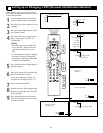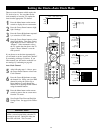
72
CARE AND CLEANING OF THE TV
WARNING
To avoid possible shock hazard, be sure the
TV is unplugged from the electrical outlet
before cleaning.
Cleaning the Cabinet
• Regularly dust the TV cabinet with a dry,
nonscratching duster.
• Gently wipe the cabinet surfaces with a
soft, clean cloth. Even if the surfaces are
very dirty, do not apply cleaner to them
directly. Soak the cloth in a solution of
cool, clean water and mild soap or deter-
gent. Wring out the cloth and wipe the cab-
inet surfaces clean. Then use a clean, dry
cloth to dry the wiped surfaces.
• Occasionally vacuum the ventilation slots
on the back cover of the set. See the next
section on “Cleaning or Replacing the
Filters.”
• Never use thinners, insecticide sprays, or
other chemicals on or near the cabinet, as
they might cause permanent marring of the
cabinet finish.
• The television contains plastic parts. DO
NOT use benzine, thinners, or other chemi-
cals to clean. DO NOT use insecticide or
other volatile substances nearby. DO NOT
allow the TV to come into contact for
extended periods of time with rubber or
vinyl products.
P
H
I
L
I
P
S
P
H
I
L
I
P
S
V
O
L
U
M
E
C
H
A
N
N
E
L
I
N
T
E
L
L
I
S
E
N
S
E
M
E
N
UP
O
W
E
R
Be sure the TV is
unplugged before
cleaning it.
Use a nonscratching duster.
Wipe with even, easy,
vertical strokes.
Avoid wearing
jewelry that may
scratch the TV.
Soak the wiping cloth in
cool, clean water and mild
detergent. Then ring the
cloth out before using.
Don’t use chemicals
on or near the TV.
Cleaning the Screen
• Wipe the screen with a clean cloth damp-
ened with water. Screen-cleaning kits with
antistatic cleaners and cloths are available.
Contact our Customer Care Center at 1-
800-531-0039 to purchase the kit.
When cleaning the screen, take care not to
scratch or damage the screen surface.
Avoid wearing jewelry or using anything
abrasive.
WARNING Concerning Stationary Images on the TV Screen:
Do not leave picture border bars or stationary images on screen for extended periods of time.This can cause uneven
picture tube aging.
Normal use of the TV should involve the showing of pictures that contain constantly moving and changing images that fill the screen. Be careful
not to leave nonmoving images on screen for extended periods of time, or to display the same images on screen too frequently, because subtle
ghost images can be left on the picture tubes. Avoid showing pictures with border bars or the same stationary images more than 15 percent of your
total viewing in any one week. Sources of stationary images may be broadcast channels, cable channels, satellite channels, digital television boxes,
DVD discs, laser discs, video games, CD-i discs, videotapes, and others. Here are some examples of stationary images (this is not an all-inclu-
sive list; you may encounter others in your viewing):
Border bars—solid bars shown when viewing a standard (4:3) picture and some
widescreen movies on your widescreen (16:9) TV; DVD menus—listings of DVD disc content; Video-game images and score-
boards; Television station logos—present a problem if they are bright and stationary; moving or low-contrast graphics are less like-
ly to cause uneven aging of the picture tube; Stock-market tickers—presented at the bottom of the TV screen; Shopping channel
logos and pricing displays—bright and shown constantly or repeatedly in the same location on the TV screen.
All picture tubes age with use, with their light output diminishing over time. But by maintaining normal use—mixing television picture types—you
will create conditions in the tubes age at an even rate. The result will be a TV picture that is evenly bright over the entire screen.


















